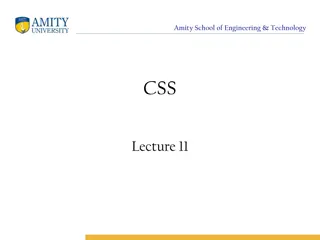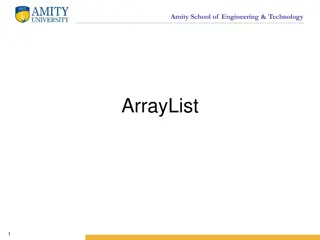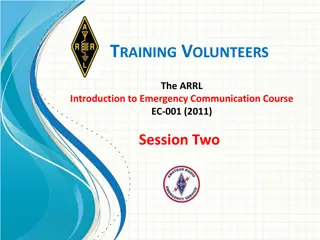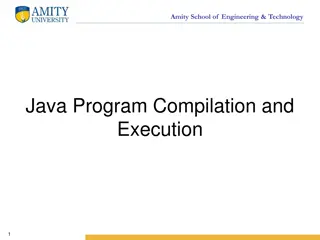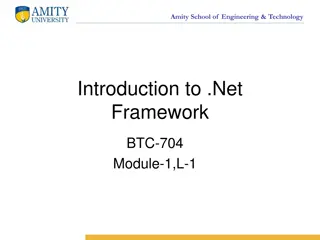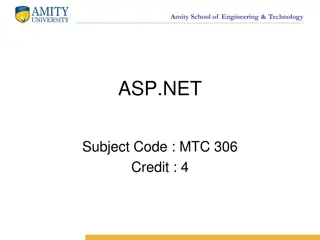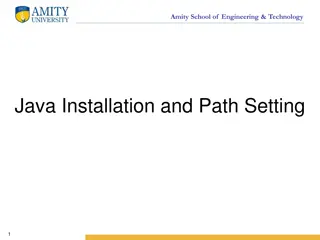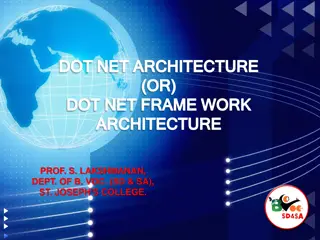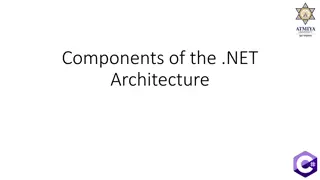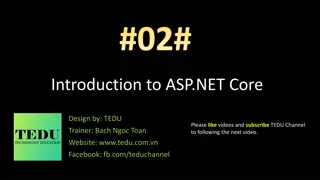Overview of .NET Framework and CLR Architecture at Amity School of Engineering
Explore the .NET Framework and Common Language Runtime (CLR) architecture at Amity School of Engineering & Technology, covering topics such as .NET components, technical architecture, common language runtime, CLR execution model, and more. Discover the support for multiple languages and the .NET languages supported, along with details on compilers, memory allocation, garbage collection, and security aspects.
Download Presentation

Please find below an Image/Link to download the presentation.
The content on the website is provided AS IS for your information and personal use only. It may not be sold, licensed, or shared on other websites without obtaining consent from the author.If you encounter any issues during the download, it is possible that the publisher has removed the file from their server.
You are allowed to download the files provided on this website for personal or commercial use, subject to the condition that they are used lawfully. All files are the property of their respective owners.
The content on the website is provided AS IS for your information and personal use only. It may not be sold, licensed, or shared on other websites without obtaining consent from the author.
E N D
Presentation Transcript
Amity School of Engineering & Technology .Net Framework BTC-704 Module-1,L-2
Amity School of Engineering & Technology .Net Architecture .NET architecture is: multi-language cross-platform based on the CLR, FCL, and JIT technology .NET components are packaged as assemblies
Amity School of Engineering & Technology .Net Architecture
.Net Technical Architecture Amity School of Engineering & Technology VB C++ C# JScript Common Language Specification Visual Studio.NET Windows ASP.NET: Web Services and Web Forms Windows Forms Forms ADO.NET: Data and XML Base Class Library Common Language Runtime
Amity School of Engineering & Technology Common Language Runtime A common runtime for all .NET languages Common type system Common metadata Intermediate Language (IL) to native code compilers Memory allocation and garbage collection Code execution and security Over 15 languages supported today C#, VB, Jscript, Visual C++ from Microsoft Perl, Python, Smalltalk, Cobol, Haskell, Mercury, Eiffel, Oberon, Oz, Pascal, APL, CAML, Scheme, etc. Rational is working on Java compiler for CLR
Amity School of Engineering & Technology The CLR Architecture Base Class Library Support Thread Support COM Marshaler Type Checker Exception Manager Security Engine Debug Engine MSIL to Native Compilers (JIT) Code Manager Garbage Collector (GC) Class Loader
CLR Execution Model (Narrow) Amity School of Engineering & Technology Code in another .NET Language Code in VB.NET Code in C# Appropriate Compiler VB.NET compiler C# compiler IL(Intermediate Language) code CLR just-in-time execution
Amity School of Engineering & Technology CLR Execution Model Source code VB C# C++ Unmanaged Component Compiler Compiler Compiler Managed code Assembly IL Code Assembly IL Code Assembly IL Code Common Language Runtime JIT Compiler Native Code Operating System Services
Amity School of Engineering & Technology How CLR works?
Amity School of Engineering & Technology CLR based execution APP.exe OS Process other FCL components JIT Compiler Core FCL obj code CLR Underlying OS and HW
Amity School of Engineering & Technology Common Language Runtime Execution Engine Compiles Microsoft Intermediate Language (MSIL) into native code Handles garbage collection Handles exceptions Enforces code access security Handles verification Managed v. Unmanaged
Amity School of Engineering & Technology Implications of CLR execution model 1. Clients need CLR & FCL to run .NET apps available via Redistributable .NET Framework 2. Design trade-off + managed execution (memory protection, verifiable code, etc.) + portability: slower execution?
Amity School of Engineering & Technology CLR and JIT compiling. Indirect execution of .Net applications. All .NET languages compile to the same CIL. The CLR transforms the CIL to assembly instructions for a particular hardware architecture. This is termed jit ing or Just-in-time compiling. Some initial performance cost, but the jitted code is cached for further execution. The CLR can target the specific architecture in which the code is executing, so some performance gains are possible.
Amity School of Engineering & Technology Advantages of CLR Support for developer services (debugging) Interoperation between managed code and unmanaged code (COM, DLLs). Managed code environment Improved memory handling Improved garbage collection
Amity School of Engineering & Technology Advantages of CLR JIT allows code to run in a protected environment as managed code. JIT allows the IL code to be hardware independent. CLR also allows for enforcement of code access security. Verification of type safety. Access to Metadata (enhanced Type Information)
Amity School of Engineering & Technology Before .NET Windows GUI development: Win32 API, MFC, Visual Basic, COM Web development: ASP Java Write once, run anywhere. Embrace and extend: Visual J++
Amity School of Engineering & Technology Life As a C/Win32 API Programmer Traditional software development for the Windows. C developers are forced to contend with complex memory management and pointer arithmetic. It lacks the benefits provided by the object-oriented approach When you combine the thousands of global functions and data types defined by the Win32 API to an already formidable language, it is little wonder that there are so many buggy applications floating around today.
Amity School of Engineering & Technology Life As a C++/MFC Programmer C++ is an object-oriented layer on top of C. Programmers benefit from the famed pillars of OOP (encapsulation, inheritance, and polymorphism). Microsoft Foundation Classes (MFC) provides a set of C++ classes that facilitate the construction of Win32 applications. It wraps a sane subset of the raw Win32 API behind a number of classes, magic macros, and numerous code-generation tools (wizards). Regardless of the helpful MFC, programming for Windows using C++ remains a difficult and error- prone experience
Amity School of Engineering & Technology Visual Basic 6.0 Programmer Ability to build complex user interfaces, code libraries, and data access logic with minimal fuss and bother. VB6 hides the complexities of the raw Win32 API from view using integrated code wizards, intrinsic data types, classes, and VB-specific functions. Not fully object-oriented No is-a relationships between types (i.e., no classical inheritance) No multithreaded applications unless you are willing to drop down to low-level Win32 API calls (which is complex at best and dangerous at worst).
Amity School of Engineering & Technology Life As a Java/J2EE Programmer Object oriented with syntactic roots in C++. Java cleans up many unsavory syntactical aspects of C++. Java provides programmers with a large number of predefined packages that contain various type definitions. Limited ability to access non-Java APIs. Little support for true cross-language integration. Not appropriate for many graphically or numerically intensive applications. A better approach for such programs would be to use a language such as C++ where appropriate.
Amity School of Engineering & Technology Life As a COM Programmer Microsoft s previous application development framework. reusable binary code. C++ programmers can build COM classes that can be used by VB6. Delphi programmers can use COM classes built using C. COM s language independence is limited. COM has no support for classical inheritance). COM is extremely complex under the hood. The Active Template Library (ATL) provides a set of C++ classes, templates, and macros to
Amity School of Engineering & Technology Windows DNA Programmer Microsoft has been adding more Internet-aware features into its family of operating systems and products. COM-based Windows Distributed interNet Applications Architecture (DNA) is quite complex. Due to the simple fact that Windows DNA requires the use of numerous technologies and languages (ASP, HTML, XML, JavaScript, VBScript, COM(+), and data access API like ADO).
Amity School of Engineering & Technology The complete maze Completely unrelated syntaxes. JavaScript has a syntax much like C, while VBScript is a subset of VB6. The result is a highly confused mishmash of technologies. Each language and/or technology has its own type system: An int in JavaScript is not quite the same as an Integer in VB6.
Amity School of Engineering & Technology .Net, the Rescuer OOP JVM GUI .NET Web component-based design n-tier design
Amity School of Engineering & Technology .Net provides Integrated environment Internet, Desktop , Mobile devices consistent object-oriented To provide a portable environment A managed environment
Amity School of Engineering & Technology What Is .NET .NET is a framework New programming methodology .NET is platform independent / cross platform .NET is language-insensitive
Amity School of Engineering & Technology .NET is cross-platform APP.exe ? Win32 (XP,2K,98) Win64 WinCE
Amity School of Engineering & Technology Narrow view of .Net applications .NET Application .NET Framework Operating System + Hardware





